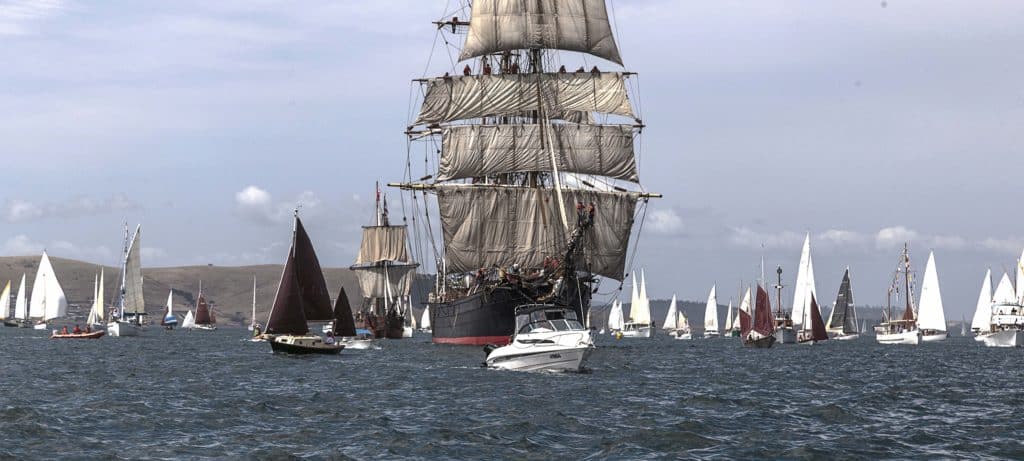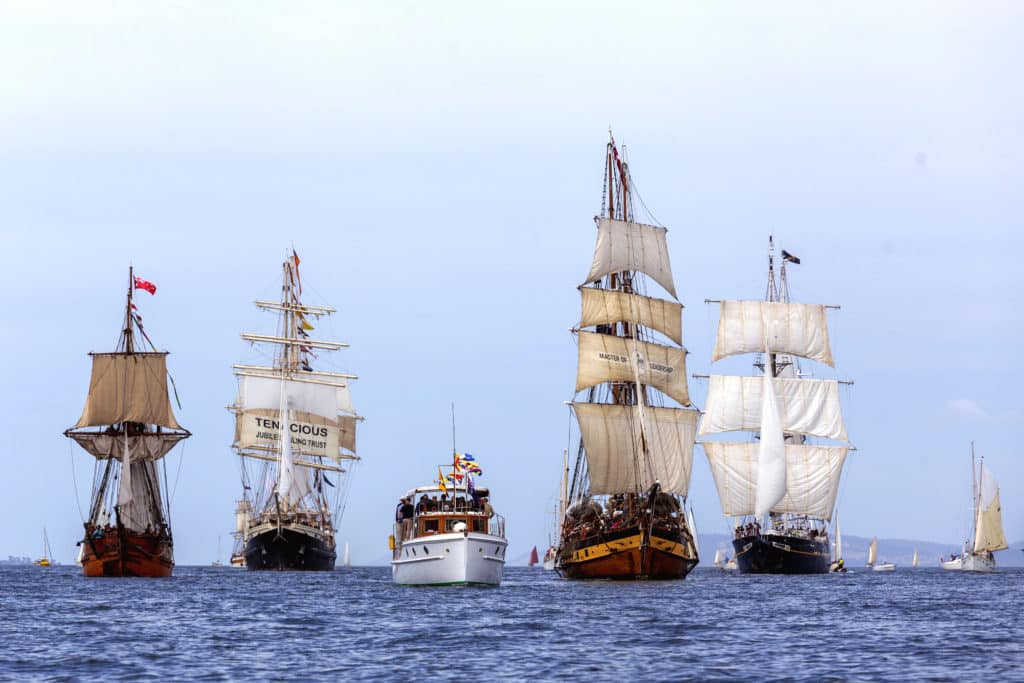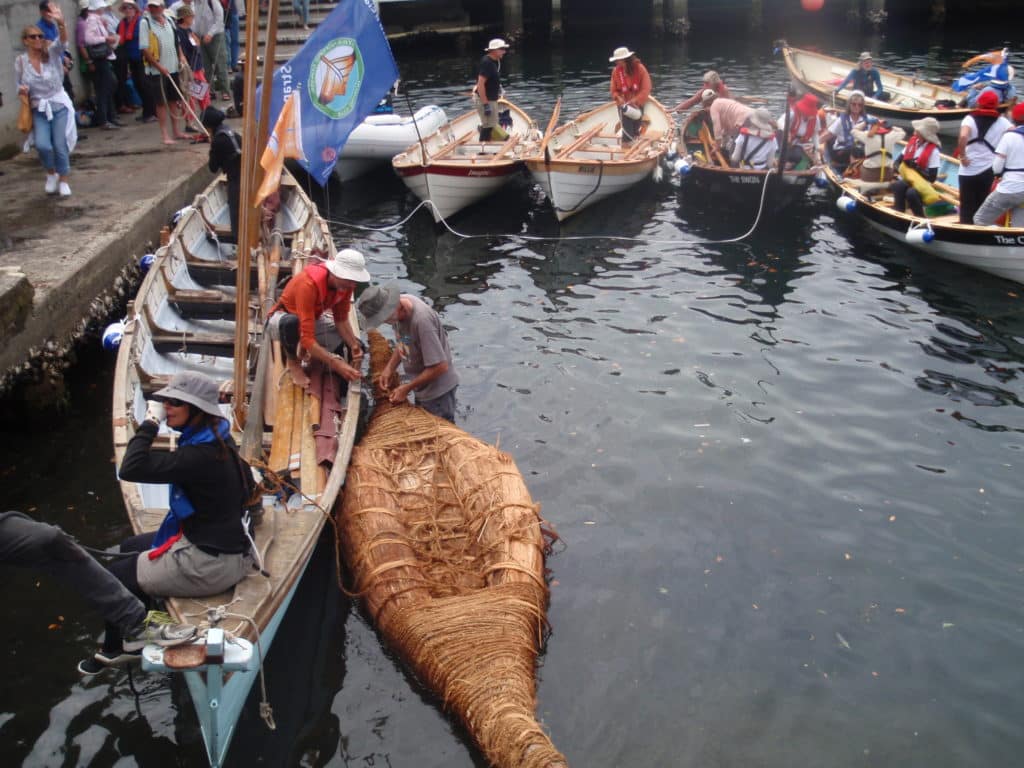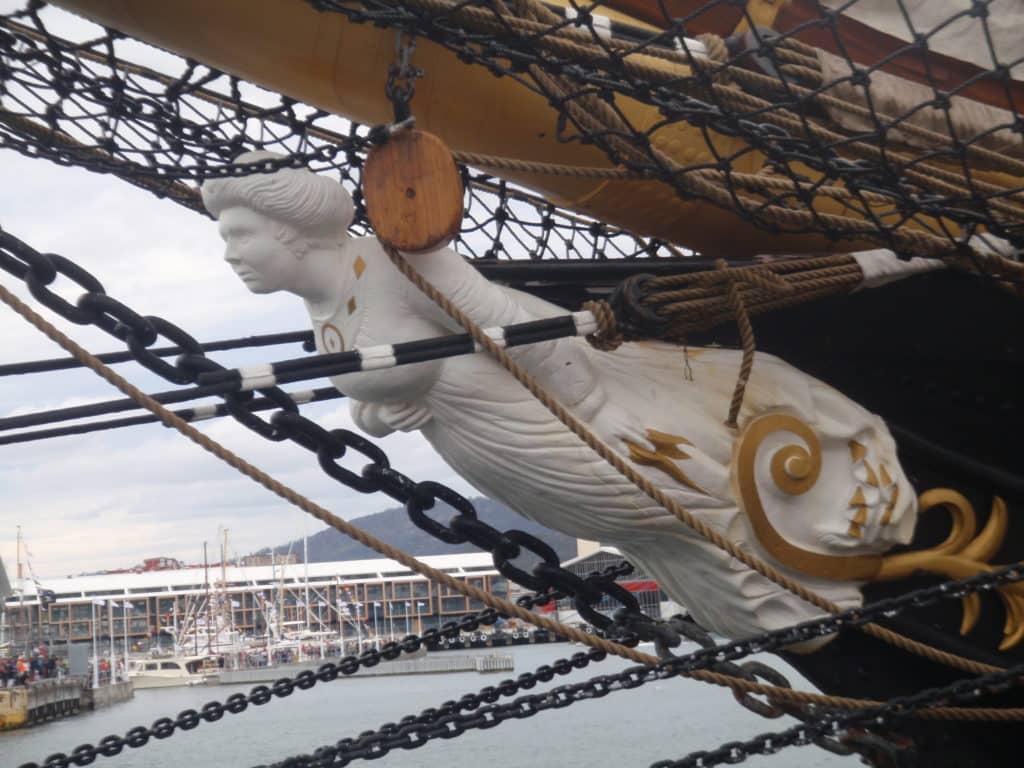
Over the years, I have been to many boat shows, and I’ve enjoyed all of them. From a business perspective, they are the perfect setting for marine manufacturers and retailers to showcase their wares and innovations. From a consumer’s point of view, they draw enthusiasts from far and wide into a critical mass of kindred spirits. No matter if you are strolling the docks on a beautiful autumn day or crowded into a convention center, sheltered from a brutal Chicago winter, the atmosphere becomes one of fun, fantasy, inspiration and education. Good things happen.
Until visiting the Australian Wooden Boat Festival last February, however, I had never been to a “boat festival,” and did not quite understand the difference. While boat shows are essentially driven by profit, festivals are driven by passion. A boat show is about the future of yachting; a boat festival is about its past. A focus on the future tends to be individual, the past collective, thus a special bond seems to develop between festival participants. But there is another difference: unidirectional cellulose fiber, aka wood. Wooden-boat people are more than mere enthusiasts; they are true believers, adherents to an ancient religion. Their flame of faith may have flickered historically, but it has never been extinguished. Their connection to wooden boats and the tried-and-true ways of yore grows beyond a hobby to become a holistic lifestyle intertwined with elements of reverence and respect.
Thanks to a host of volunteers and perhaps some local municipal sponsorship, most festivals are free to the public. The “displays” are mostly the treasured vessels of amateur wooden-boat owners with no other incentive to attend than the pride of ownership. Somehow, the shared dedication of preserving elegant icons of an age past combines with every sailor’s need for a grand ol’ party to create a palpably friendly atmosphere.
There are three major and many minor festivals worldwide. Brest, in France, hosts Europe’s largest every four years, the next being in 2020. Because of its proximity to major European ports, this festival boasts the attendance of numerous historic Tall Ships plus a large complement of traditional recreational vessels. The docks hold an eclectic crowd, the Celtic music is loud and the food and wine are of the best French standard.
Port Townsend, Washington, which years ago might have been considered a hippie holdout in nautical terms, has matured into a vibrant sailing town, and is now recognized as the epicenter of traditional boating for the entire West Coast. From humble beginnings 40 years ago, the Port Townsend Wooden Boat Festival has grown into a world-renowned event. With more than 300 vessels on display, top-quality music, food, lectures and other family-friendly events, the annual September show bustles to overflowing. The early success of the Wooden Boat Festival gave birth to the Northwest Maritime Center, which has served more than 150,000 students of all ages in areas such as boatbuilding, sailing, maritime safety and community activism.
And in a galaxy far, far away, there is the aforementioned Australian Wooden Boat Festival held every two years in Hobart, Tasmania. Admittedly, this is down under even by Australian standards. But distance notwithstanding, with 455 vessels featured in its 2017 festival, it is certainly the largest “wood only” event and perhaps the largest in any terms. All claims of size aside, the AWBF is a world-class extravaganza. Any sailor with caulk in their seams should make this pilgrimage at least once in their lifetime.

Feature Vessels, Parade of Sails, AWBF 2017, Hobart, Tasmania, Australia
I finally did so and was thrilled with what I found. It all starts with authenticity. The Dutchman Abel Tasman first laid eyes upon this glorious island 375 years ago (more on that to come). It languished in European terms until the British established a colony on the banks of the Derwent River in 1803 and named it Hobart Town. It is Tasmania’s remoteness that has made it so significant in maritime history because, by nature, everything happened by ship.
Early settlers discovered massive groves of trees in the nearby Huon Valley. Huon pine (Lagarostrobos franklinii) is one of the oldest living organisms on Earth, with one tree calculated to be 3,462 years old. It is very slow growing, with a tight grain, and oozes with insect-repelling oils. It is said that the only thing slower than the Huon pine’s growth is its decay, making it the perfect ship-building wood. It gave birth to a massive ship-building industry, the legacy of which survives to this day.
Hobart has retained much of its historically quaint architecture. Fortunately, old taverns feature prominently. It is the perfect stage for celebrating the glorious era of sail. The entire waterfront became a floating beauty contest, simply open to the public without charge. Dozens of musical groups rotated between strategically placed amplified stations. The smell of ethnic cuisine wafted out from rows of food stalls. Wood chips flew at several boatbuilding demonstrations next to grizzled lobstermen handcrafting old-fashioned lobster pots from a native cane. Seminars included a host of local luminaries as well as international speakers, such as yacht designer Ron Holland, author Lin Pardey and photographer Benjamin Mendlowitz.
The main docks were dominated by gargantuan square riggers, such as Tenacious, the largest wooden ship built in the United Kingdom in over a century. After a little controversy involving a wooden “ship” that actually sits on land and serves as a restaurant in Dubai, at 213 feet overall and carrying 13,000 square feet of canvas, Tenacious now holds the official record of being the largest wooden ship afloat. The midsize square riggers and schooners included Yukon, Windward Bound, Lady Nelson and, arguably the prettiest of them all, Julie Burgess.
The floating docks shimmered with national flags, burgees and pennants. The docks glistened with hand-rubbed varnish and polished brass. My head and heart got turned in every direction. Fashion and function were not mutually exclusive; these were sailing sculptures. They were art you can leave out in the rain.
Here was the George Luckman-designed-and-built Terra Linna, circa 1880, the oldest racing yacht afloat in Tasmania. But by no means is it the oldest design. A replica of the Aboriginal cork-weed-and-strip-bark canoe, lashed together with over 1,600 feet of handmade rope, paddled by. Its origins reach back an estimated 42,000 years. It is named Rrala, which means “strong” in the Palawa kani language. It serves as a humbling reminder that we contemporary sailors were not the first on the water.
Rrala passed under the elegant stern of Holger Danske, an Aage Nielsen 41, winner of the 1980 Newport Bermuda Race. I eavesdropped on the language of the aficionados as they perused the spectacle and heard adjectives more frequently reserved for wine bottles: sassy, sultry, robust, supple, approachable…

There were plenty of personalities to go with these unique vessels. On the diminutive Cape Stormy, I met the indomitable 89-year-old Peter Maussey, who in 1953, with his beautiful wife, Lesley, became the first Australian couple to circumnavigate. He is known as the “Million Mile Man;” between his cruising and yacht deliveries of many decades, he has logged up an incredible tally of trips and tales.
The docks were full of long sprits and high spirits. With close to a quarter million people in attendance, shoreside accommodations were tight. Problem solved: Bring in the cruise liner Ovation of the Seas, with 5,000 passengers treated to a bird’s-eye view of the show below, the highlight of which is the Parade of Sail. All the vessels gathered in the bay in front of Hobart and formed an exquisite sail-by for cheering crowds on the shore. If you love the sea and all that sails upon it, this cloud of canvas is almost a sensory overload.
Each biennial festival centers on a specific theme. This year’s was the celebration of the 375th anniversary of Tasman’s famous voyage. The local museum created a comprehensive historical display of Tasman’s journey replete with authentic memorabilia. The Dutch ambassador opened the ceremonies. A contingent of Dutch sailors came over with several historical designs, such as the 20-foot shoal-draft Tjotter class. A team of Dutch boatbuilders constructed a Regenboog (rainbow)-class boat from old celery-top pine and ultimately raced against a local Tasmanian crew in a Gnome-class sloop. Special Dutch food, music and classic vessels completed the celebration of that nation’s rich maritime history.

Why is this important to us? Because the theme of the 2019 Australian Wooden Boat Festival is Americana! This is an opportunity to share our amazingly rich maritime heritage with sailors from around the world and forge special ties with our antipodean brothers and sisters of the sea. Historians, boatbuilders, designers, speakers, musicians, authors and just plain intrepid tourists, take note. Here we can showcase and celebrate the graceful designs of John Alden, Nathanael and L.
Francis Herreshoff, Olin Stephens, William Atkin, Philip Rhodes, William Tripp and too many more to mention. (Who is your favorite?) And what of our mighty Tall Ships and schooners? Oh, Roseway, you still hold my heart. America has a deep and abiding connection to the sea, and that is so wonderfully preserved by our many fine maritime museums, such as Mystic Seaport, Maine Maritime, Peabody Essex, New Bedford Whaling Museum and so on. Imagine the contributions to this marvelous event they could make.
Pacific cruisers can start planning an itinerary now that will land them on Tasmanian shores by February 2019. They will find Hobart a safe and welcoming harbor. After the festival, they will experience almost limitless pristine cruising grounds offering spectacular geography and unique flora and fauna.
My wife, Diana, and I stayed aboard the Radford-designed, cedar-strip-planked Bindawalla courtesy of longtime sailing friends and circumnavigators John and De Deegan. I so enjoyed being smack in the middle of the action that I plan to sail our own Roger Henry over there for the next festival. I want to be downwind of all that pine tar and simply soak up all that tradition.
Upon its conclusion, I hope to explore the wilder southwest coast of Tasmania, enjoy the increasingly famous culinary delights and fine wineries, and perhaps sample a wee dram of what has been voted “the best whiskey in the world,” produced in a little distillery nearby. We are often told that life is a journey, not a destination. In a sense, the Australian Wooden Boat Festival in Hobart is a bit of both.
– – –
Contributing editor Alvah Simon is the author of the critically acclaimed best-seller North to the Night.








